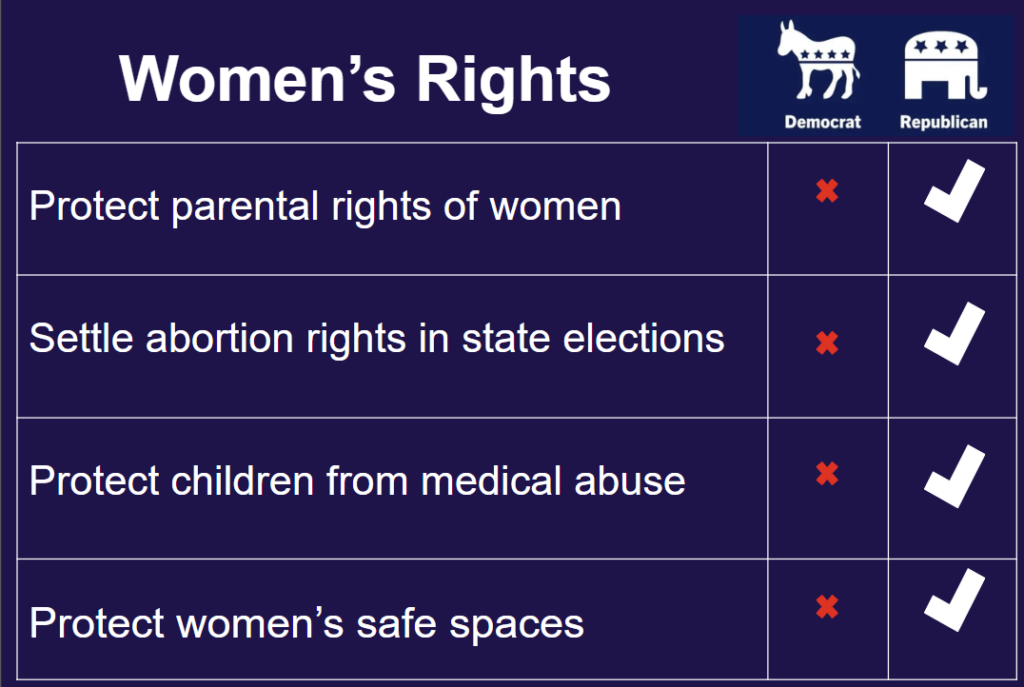
The discussion on women’s rights is often narrowly focused on the issue of abortion.
While it is undoubtedly important, there are other very big concerns that need attention. Reducing women’s rights to a debate over terminating pregnancies overlooks the complexities and challenges women face in areas such as:
- Parental rights
- Protection of children from medical abuse
- Safeguarding of women’s safe spaces.
These dimensions are critical to ensuring women can live freely, safely, and without compromising their well-being or that of their children.
Protecting Parental Rights
A growing issue threatening women’s rights is the erosion of parental authority.
Mothers are increasingly positioned as oppressors of their own children, particularly when it comes to issues like education and gender identity.
School administrations and activist teachers, acting in the name of progressive ideologies, often undermine parental rights by withholding information from parents or actively promoting decisions that expose children to predators.
A clear example is the increasing trend of schools encouraging children to explore gender transitions without informing or consulting their parents.
These children, many of whom are still grappling with their sense of self, are exposed to third parties who may not have their best interests at heart.
This disempowers women, particularly mothers, by stripping them of their right to safeguard and nurture their own children, while leaving children vulnerable to predatory ideologies and even predators.
Women must defend their rights as mothers and caregivers, resisting any encroachment on their ability to make informed decisions for their children’s safety and development.
Settling Abortion Rights Through State Elections
Abortion has long dominated the conversation around women’s rights.
However, it is an issue that demands nuance, especially when framed as one that extends beyond the first few weeks of pregnancy. The majority of abortions occur early in pregnancy, and for women who face difficult choices after 6 weeks, it is often due to fear, stigma, or a lack of support. These women need compassion, not divisive rhetoric that denies the humanity of the unborn child.
State elections provide a pathway to address this sensitive issue with the seriousness it deserves.
By allowing voters to decide, communities can shape abortion laws in ways that align with their values while ensuring that women facing these difficult choices have access to education, support, and alternatives.
Rather than framing the debate as one about “rights” to terminate life, the focus should be on raising awareness, reducing stigma, and giving women the resources they need to make informed decisions.
The right approach is to educate, empower, and provide support—not to perpetuate a narrative that denies the moral complexity of ending a pregnancy.
Protecting Children from Medical Abuse
In recent years, the push for so-called “gender-affirming care” has resulted in disturbing trends.
Children as young as 8 years old are being put on puberty blockers, and young girls, barely into their teenage years, are undergoing irreversible surgeries such as mastectomies.
Parents are frequently misled into believing that if they do not allow their children to pursue medical transitions, their children will be at heightened risk for mental health crises, including suicide.
This aggressive medicalization of children must be viewed as a form of abuse.
Young girls, in particular, are being subjected to procedures that will affect their ability to have children in the future, undermining their autonomy and bodily integrity before they are even capable of fully understanding the consequences.
Medical practitioners who promote these treatments should be held accountable for the lifelong damage they are causing.
Women must protect their daughters from this form of exploitation, advocating for stricter regulations and more cautious approaches when dealing with minors.
It is the responsibility of society, especially women, to ensure that children are protected from unnecessary and harmful medical interventions.
Protecting Women’s Safe Spaces
Another critical area in which women’s rights are under threat is the erosion of safe spaces.
The growing acceptance of men competing in women’s sports and entering women’s bathrooms and locker rooms has put women at risk in spaces that were once designed specifically for their safety and dignity.
Women who speak out about this issue are often punished, labeled as bigoted, or ostracized.
For instance, in sports, male athletes identifying as women are increasingly dominating competitions that were designed to give women equal opportunities.
In bathrooms and locker rooms, women are losing the right to privacy and safety.
A chilling example occurred when a female inmate in a U.S. prison was assaulted by a biological male who had been housed with her due to gender identity laws. These incidents demonstrate that the protection of women’s spaces is not only a matter of fairness but one of safety and dignity.
Women must be vigilant in defending these spaces, ensuring they remain reserved for those they were designed to protect.
A Broader View of Women’s Rights
In conclusion, women’s rights cannot be reduced to a narrow focus on abortion.
The right to terminate a pregnancy is not the sole measure of women’s liberation or autonomy. Instead, women must consider the multifaceted challenges they face today: the erosion of parental authority, the medical abuse of children under the guise of gender-affirming care, and the loss of safe spaces.
The fight for women’s rights is about ensuring that women have the power to make decisions that protect themselves, their families, and their dignity.
Women must not be swayed by narrow political narratives that reduce their rights to a single issue. The future of women’s rights requires that women stand up for themselves, their children, and the next generation—on multiple fronts.


